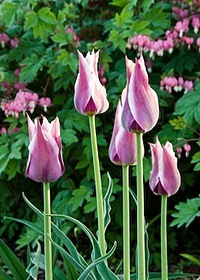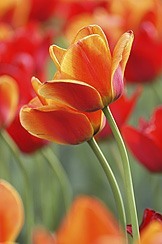
Lily-flowered tulip ‘Ballade’ goes beautifully with bleeding hearts
Spring bulbs are the icing on the cake in your flower garden. That’s why it’s best that you plant them last – after you’ve planted your perennials and shrubs.
If you put the bulbs in first, it can be hard to add other plants without disturbing and ruining the bulbs.
I had this problem in my first garden because the tulips planted by the previous owner were always in the way of doing my own gardening thing. I finally removed most of them, so I stop worrying about spearing bulbs while planting.
Design tips for spring bulbs
Combine flower bulbs with perennial for a succession of bloom.And there’s a big bonus: the emerging perennial foliage hides bulb foliage as it yellows and dies off.
Keep in mind the bulb color, time of bloom and height of the plants and consider which bulbs will mix best with nearby perennials and spring-flowering shrubs. Your combinations can be color echoes, such as the ‘Ballade’ tulip with bleeding heart, shown right, or color contrasts such as yellow daffodils with blue muscari.
Concentrate your display where it will be most effective in spring.Lots of bulbs in one or two areas of the garden close to the house will give you more bang for your buck than the same number spread all over the garden.

Avoid planting bulbs in rigid toy soldier-like rows. Generous “bouquets” are far more dramatic than a smattering here and there. Combine different bulbs by planting low-growing grape hyacinths and scillas in front taller tulips and daffodils.
Try planting in layers. Place large later spring bulbs, such as tulips, daffodils orornamental onions at the bottom of the planting hole, cover them with a layer of soil, then, on top, plant smaller early flowering bulbs such as scilla that require shallower planting.
For more generous-looking groupings position bulb drifts in a triangular patterns in the garden with the point of the triangle showing towards the front.
More Bulb Info
Crocus delivers on early spring color
Unusual bulbs that should be better known
When exactly in fall is the best time to plant bulbs




